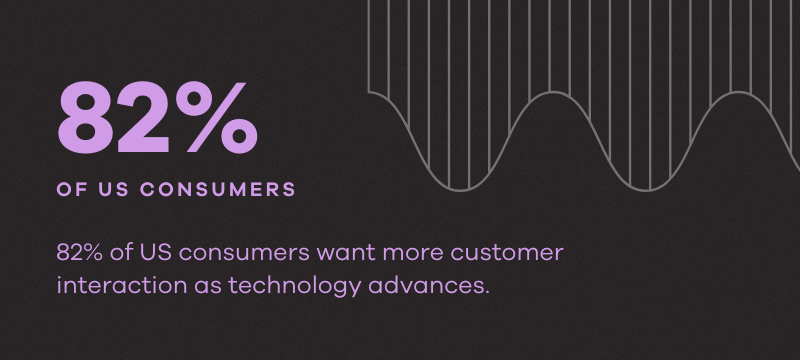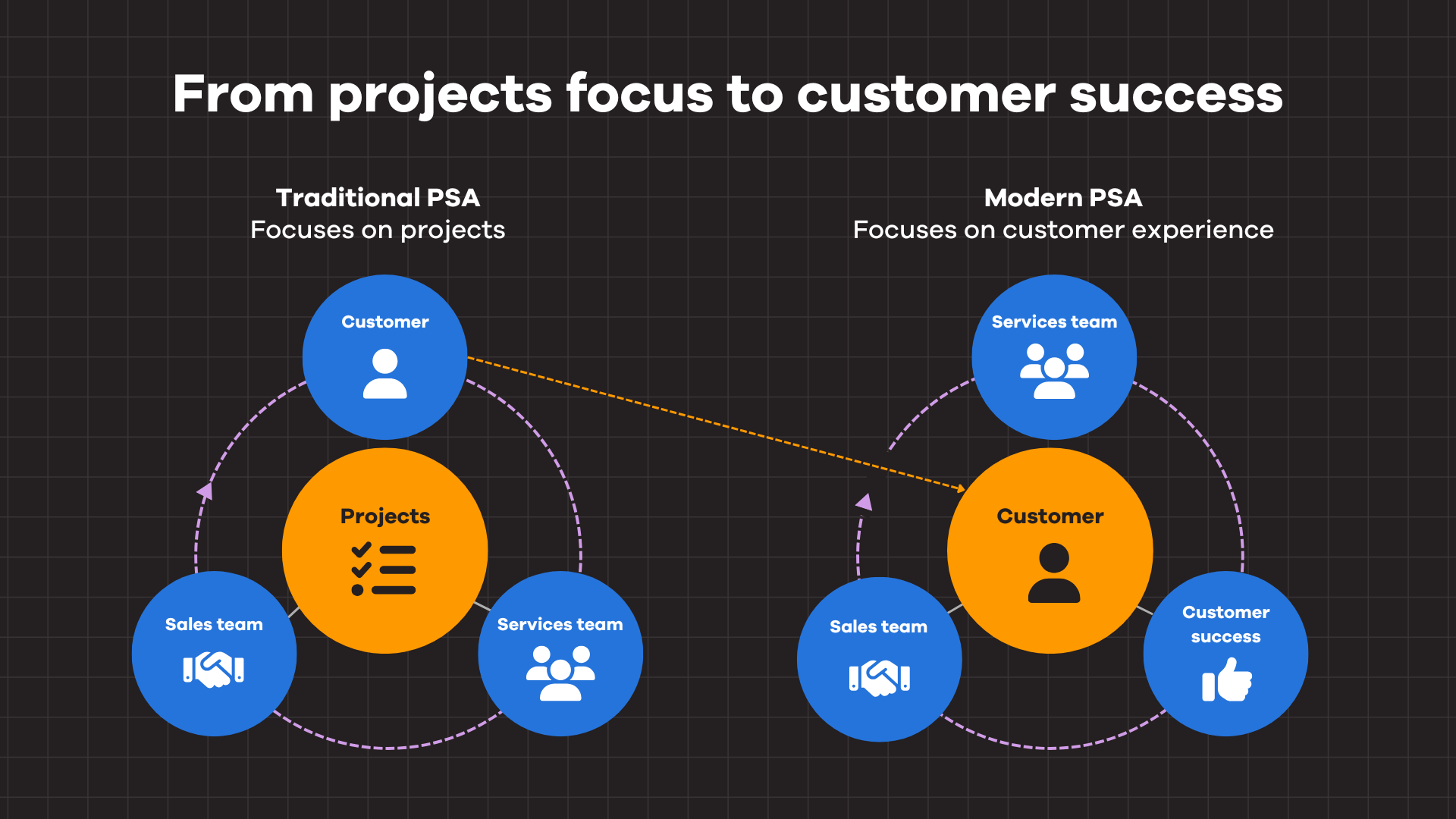For years, companies have chased the elusive goal of achieving customer success. Yet, many still struggle with it, even in professional services. So, what does customer success in the professional services industry look like?
This is a critical hurdle to overcome when the industry relies on customers to keep the wheels turning. However, with expectations and professional services trends always moving, how can consulting firms (otherwise known as professional services organizations – PSOs) or embedded professional services teams (ESOs) make a customer success strategy work?
The answer is an intentional approach to the customer experience. While the strategy may vary a bit from PSOs to ESOs, it comes down to putting the work into understanding each customer’s needs and challenges. It involves building strong relationships and delivering value to customers. Half the work is already naturally done in professional services when trying to solve your customer’s complex problems.
This guide provides practical strategies for improving customer success initiatives in professional services. It will show you how not only to meet but exceed client expectations.
What is Customer Success in Professional Services?
Customer success in professional services is focused on ensuring clients achieve long-term value internally (within an organization with ESOs) or externally (PSOs).
Customer success focuses on building long-term partnerships. It goes beyond traditional project delivery to factor in client satisfaction along the project delivery lifecycle. The goal is to align services with client goals and support them as their needs evolve.
This approach makes it easy for clients to see the actual value of their investment and for businesses to adapt to industry changes more quickly. It bridges gaps by ensuring clients receive quality services and seeing how those services contribute to their success.
Why Does Customer Success Matter in Professional Services?
Customer success, or client success, is a part of professional services. Each client often has unique goals they need to accomplish. Professional services teams play an essential role because they help customers bring their vision to life
When you focus on customer success, you ensure that customers feel heard and valued. This approach factors the entire customer experience, including how project teams interact with your customers and how customers receive support phone calls, emails, and live chats. Put simply, customer service (and success) is an inherent part of professional services.
The goal is to keep customers happy and encourage them to return, which benefits both clients and companies. Companies that have customer success down to science can increase client retention rates. Zendesk found that 80% of businesses plan to invest more in customer experience.

Professional services require unique skills and key responsibilities to deliver customer value because customer success is a massive part of their role. These team members have various roles, from project managers to technical services leads to finance. These experts roll up their sleeves to solve clients’ complex issues and ensure customer success, whether they’re PSO or ESO.
Customer Success in Professional Services Matters
Professional services is a massive industry with increasing demand. The market has been growing and is expected to reach a $95B USD market volume by 2029. Understanding customer success in professional services is important for managing project costs, margins, and other key factors that impact your bottom line. Customer success, or client success, is the end game.
In summary, customer success enhances client relationships. Professional services offer expert solutions while also focusing on building strategic partnerships. There is more to professional services than merely supporting tactical projects.

Customer Success Managers in Professional Services
In some firms, customer success and professional services are two different functions. Professional services rely on client input to keep projects moving forward. When a Customer Success Manager or Account Manager engages early on, they can provide the resources and additional support needed to stay on the right course.
Change management is another area where your customer success strategy, program, and professional services intersect. Client growth shouldn’t stop after a project or training ends. Your customer success program can guide customers along a long-term path to success and value realization, which drives retention and expansion over time. Strong collaboration between the customer success team and professional services helps prevent friction and ensures a positive experience throughout the client relationship.
Should We Combine Customer Success and Professional Services Roles?
Some firms combine customer success and professional services roles, which may work well for some but isn’t a catch-all solution in every circumstance. Professional service roles often need specific technical expertise and focus on time-sensitive tasks.
This can conflict with customer success’s proactive nature. If team members juggle key responsibilities in both roles, the strategic work of account and customer success managers might fall behind project demands.
Combining roles can work well in cases where the product is easy to implement or mostly self-service. Customer success can guide clients through onboarding, improving the overall relationship. If training is straightforward or automated, the customer success solution or rep can establish themselves as solution experts.
To avoid complications when merging these roles, consider these tips:
- Be realistic about roles and responsibilities when managing workloads.
- Set aside specific time blocks for project and customer success management.
- Make it a habit to regularly check in with clients for feedback on projects and relationships.
Balancing projects and customer relationships can be challenging for professional services firms. Take a moment to determine if merging customer success and professional services works for your organization. You don’t want to jeopardize project outcomes or long-term client relationships. If you combine them, carve out time and clearly define goals for both parts of the job.
Customer Success: How Do You Succeed in Professional Services?
Customer success in professional services isn’t just about keeping the lights on. To make customer success genuinely effective, the focus must be on consistently delivering real value to clients. Customer success and professional service efforts play an essential role here. It ensures clients achieve their goals and feel supported throughout their journey, leading to long-term relationships and repeat business. Here’s how you can drive growth in professional services.
1. Break Down Silos
Top professional services firms work closely with clients at every step to build solutions that deliver real value. This collaboration is critical.
Firms communicating openly with their clients can better understand their needs and work through challenges together. When both sides collaborate, everyone benefits.
Breaking down silos between professional services and customer success teams is key. When customer success teams engage directly with project teams at the beginning of an initiative, it simplifies the overall account management process. Providing client success and professional services sales teams with tools to generate work plans and budgets without relying on billable staff speeds up responses to client needs.
2. Keep an Eye on Client Needs
Clients’ needs are never static. As time passes, different options become available to service them, which means firms must adapt to stay competitive. Customer success teams must, too.
The consulting landscape, for example, is changing. The Economist notes that companies like McKinsey are experiencing slower growth and facing more competition from technology. With economic uncertainty and the rise of AI tools, professional services are shifting.
Firms need to adapt their strategies to meet clients’ changing needs. Tools like Upland PSA can help. They make it easier for firms to make informed decisions based on real-time data. You can keep your finger on the pulse of clients’ needs and stay proactive.
As Paul Wright, CIO of Accuride, puts it, “If we can stay better connected with our customers, if we can respond better to their needs if we can stay connected with our suppliers and maintain our relationships with them in really difficult times, then that should give us a competitive advantage in the future.”
3. Focus on The Customer Experience
Customer expectations have never been higher, and patience has never been thinner. Today’s clients want expert support, a seamless experience, and something that delivers proven ROI quickly. To meet these demands, professional services must focus on being precise, easy to work with, and reliable.
However, it’s not only about making processes easier for customers. They also need the human touch to feel valued and understood. PwC found that 82% of U.S. consumers want more of it as technology advances. When customers feel appreciated, they tend to spend more and remain loyal. Quality human interaction is where customer success comes in.

A bad customer experience can drive customers away faster than you think. PwC also found that 59% of consumers will leave a brand they love after just a few bad experiences. Even more concerning, 32% would stop doing business with a company after one negative customer experience.
4. Solve Problems Before They Escalate
When teams work together, they can anticipate issues and catch early warning signs during check-ins. Customer success and professional services can do this.
This proactive approach lets them take action before issues escalate. Anticipating and solving problems before they take hold builds trust and highlights the firm’s value. Clients who feel supported strengthen their relationships with the firm, boosting its reputation in a competitive market.
Regular customer feedback mechanisms like project milestone surveys help firms gauge customer satisfaction continuously. This approach allows for prompt adjustments, improving the overall client experience. Using analytics tools also helps identify patterns in client behavior. This lets teams address potential concerns before they grow into significant issues.
With Upland PSA’s data insights, firms can read the room. Predictive analytics help businesses shift from reactive to proactive. It keeps them a step ahead of client needs and fine-tunes their service.
5. Grow and Improve Together
Building solid client relationships opens doors to upselling and cross-selling down the line. Customer success teams help by keeping client goals front and center. They can further emphasize the services’ real value, tightening client bonds. It also opens up fresh revenue streams, making growth feel more natural and tuned to clients’ needs.
Encouraging clients to share their experiences through testimonials or case studies enhances your firm’s credibility. Satisfied clients are more apt to happily advocate for your services, creating a positive feedback loop that attracts new business.
Client success also drives a culture that continually raises the bar rather than just meeting expectations. It offers clients a dedicated space where they can share feedback. Sharing these insights across internal teams helps everyone stay plugged into client expectations and prioritize customer success. Altogether, this approach creates better outcomes while building a more resilient foundation for growth.
6. Match Resources to Client Needs
In professional services, success is all about putting the right skills where they’re needed most. Matching expertise to client needs builds trust, whether onboarding, expansion, or renewal.
This is where your customer success and customer support team become essential. Just adapt your support to fit each project to ensure client success. High-complexity projects might need hands-on help, while simpler ones can run smoothly with a lighter touch.
Also, keep skill inventories updated and forecast resource needs so you’re always ready. Tools like Upland PSA make this simple. It allows you to track skills and monitor your capacity to plan confidently.
7. Make Knowledge Your Advantage
Forbes notes that knowledge workers spend about 25-30% of their time searching for information, which hasn’t changed in years. Centralized access to documented information about what’s happening with each customer can help reduce that time. By building a solid database, teams can easily tap into project-specific details, allowing them to respond to client inquiries quickly.
That said, building a consistent process to capture knowledge from various groups, such as customer success and professional services, can be challenging. Firms should keep their eye on a few key areas:
- Finding process gaps
- Choosing the right technology and ensuring it’s used effectively
- Clarifying the benefits for users
- Encouraging team collaboration
By prioritizing knowledge management, firms and teams (such as customer success and professional services) can work more efficiently and adapt better to client needs, setting them up for long-term business success.

Drive Customer Success with Upland PSA
Nowadays, most firms claim to be customer-centric. However, this isn’t easy to achieve. Professional services organizations and their clients are constantly changing, and firms must stay nimble to keep up. If they can’t adapt, they risk losing out on valuable clients.
Organizations must understand and adapt to changing demands to keep customers returning. Tools like Upland PSA allow firms to tap into real-time analytics and make quick decisions that match client expectations.
Don’t let your firm fall behind. Try Upland PSA now and see how it can help your customers succeed. Let’s chat.
